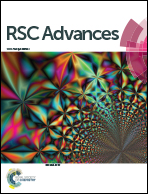Hierarchical Co–FeS2/CoS2 heterostructures as a superior bifunctional electrocatalyst†
Abstract
The traditional method of preparing hydrogen and oxygen as efficient clean energy sources mainly relies on the use of platinum, palladium, and other precious metals. However, the high cost and low abundance limit wide application of such metals. As such, one challenging issue is the development of low-cost and high-efficiency electrocatalysts for such purposes. In this study, we synthesized Co–FeS2/CoS2 heterostructures via a hydrothermal method for efficient hydrogen evolution reaction (HER) and oxygen evolution reaction (OER). Benefitting from their unique three-dimensional hierarchical nanostructures, Co-doped FeS2, and CoS2 formed heterostructures on Co–FeS2 petals, which bestowed remarkable electrocatalytic properties upon Co–FeS2/CoS2 nanostructures. Co–FeS2/CoS2 effectively catalyzed the OER with an overpotential of 278 mV at a current density of 10 mA cm−2 in 1 M KOH solution, and also is capable of driving a current density −10 mA cm−2 at an overpotential of −103 mV in 0.5 M H2SO4 solution. The overpotential of the OER and HER only decreased by 5 mV and 3 mV after 1000 cycles. Our Co–FeS2/CoS2 materials may offer a promising alternative to noble metal-based electrocatalysts for water splitting.



 Please wait while we load your content...
Please wait while we load your content...